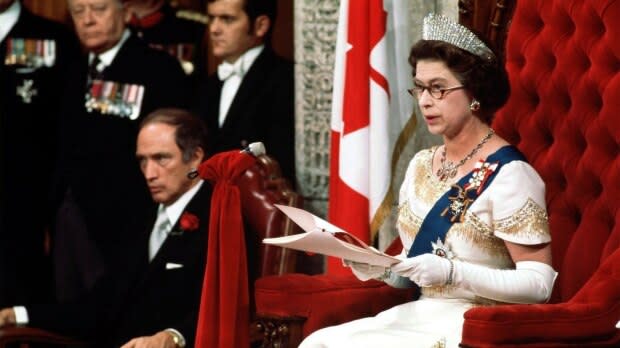Pomp and policy: What is the throne speech, anyway?
Today, Canada draws on the pomp and ceremony of the British part of its heritage as the speech from the throne opens the new session of Parliament.
The affair leans into connections to British parliamentary traditions that date back centuries. Today, the reasons for many of those traditions and ceremonies are less widely known.
To help guide you through today's events, here are some answers to commonly asked questions about the speech from the throne.
What is it?
The speech from the throne is essentially a legislative to-do list the sitting government lays out for the House of Commons and the Senate at the start of each new parliamentary session. Until the speech has been read, no other parliamentary business can take place — no bills, debates or Commons votes.
Why is it important?
The speech from the throne lists the issues and policies the government wants to address over its term, and the laws it plans to table. It's also meant to put the government's political objectives in context by outlining the state of the country and the challenges it faces.

Who reads it?
The Governor General reads the speech — but the prime minister and officials in his office actually write it. While Gov. Gen. Julie Payette will read this year's speech, on two previous occasions — Oct. 14, 1957 and Oct. 18, 1977 — the Queen herself read the speech from the throne.
Why the Governor General?
Formally, Parliament sits at the pleasure of the sovereign. So, in Britain, the Queen reads the throne speech from an actual throne in the House of Lords. The Governor General, the Queen's representative in Canada, takes that role in this country, reading the speech from a seat in the Senate chamber reserved for the head of state or her representative.
This year will be a little different. The centre block of Parliament — the building containing the parliamentary library, the Senate and the House of Commons — is still under construction. So for the first time, the Governor General will be reading the throne speech from the Senate of Canada Building, the temporary home of the Senate which was once Ottawa's central train station.

What is the Usher of the Black Rod?
It's a position that dates back to 14th-century England and it has several ceremonial and security-related duties. One of these duties is to act as the Queen's messenger in Parliament.
The Usher leads the procession into the Senate chamber. Once the Governor General arrives, the Speaker of the Senate asks the Usher of the Black Rod to summon MPs from the House of Commons.
CBC coverage of Thursday's throne speech
Rosemary Barton hosts special coverage of the speech from the throne beginning at 2 p.m. ET on CBC News Network, CBCnews.ca and Facebook. Tune in to CBC Radio One for coverage of the speech starting just before 3:30 p.m. ET. And find analysis and reaction on CBC News Network's Power & Politics at 5 p.m. ET, World at 6 on CBC Radio One and on CBC TV's The National at 10 p.m.
When the Usher arrives at the House, MPs — following a very old tradition — slam the door in his face, an act meant to symbolize the Commons' independence from the Crown. The Usher then uses the base of his ceremonial staff to knock on the Commons door three times, summoning MPs to the Senate.
The Usher leads MPs to the Senate and, once the speech is over, heads the procession out of the Senate.

What happens after the speech?
Right after the speech, the Senate and the House of Commons return to their respective houses of Parliament to begin the sitting by introducing something called a "pro forma" bill.
Bills S-1 in the Senate and C-1 in the Commons are introduced and are given a first reading. The introduction of these bills is also a part of the tradition — a way for both houses to demonstrate their independence from the Crown by introducing legislation without following the directions laid out in the throne speech. Once the bills are tabled, their purpose has been served and they are pursued no further.
What is the reply to the speech from the throne?
Later in the day, an MP from the government side in the House of Commons stands to offer a government reply to the Governor General, thanking her for delivering the speech. Another MP chosen by the prime minister seconds the reply.

